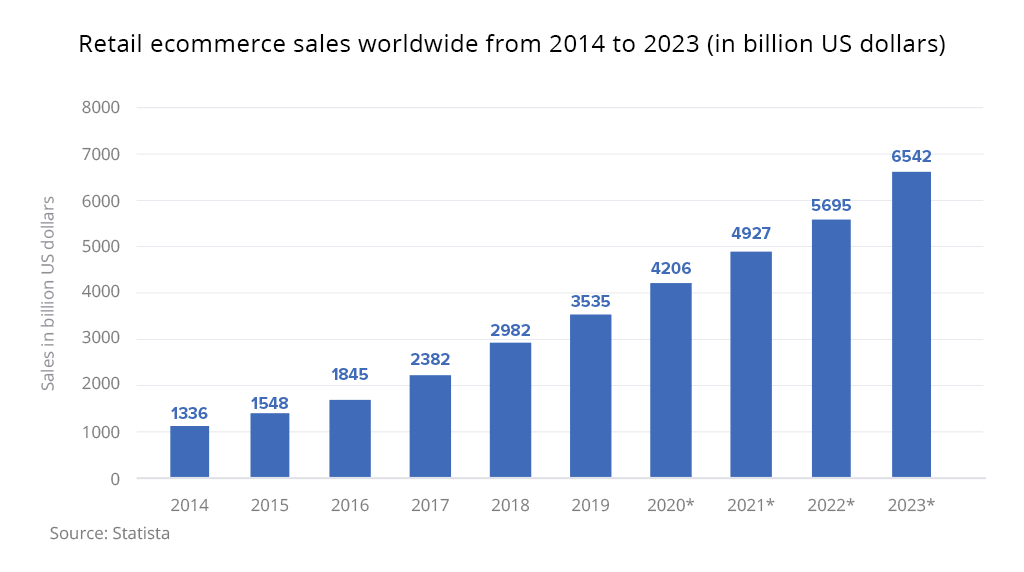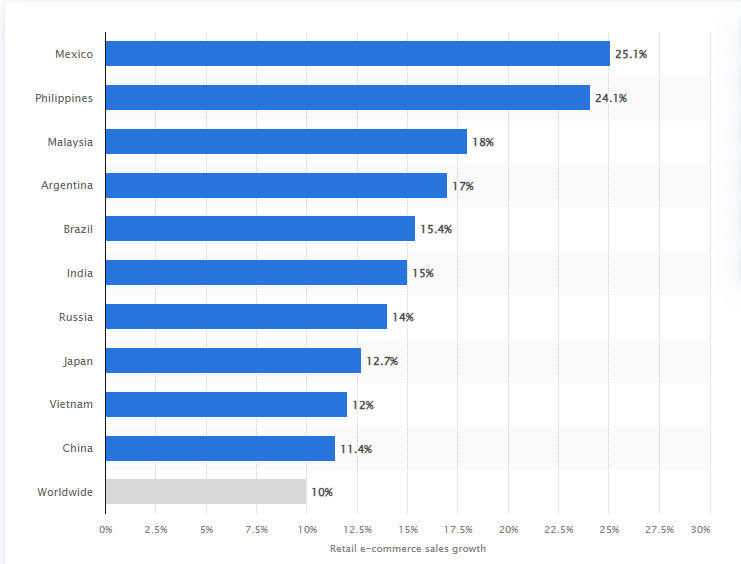Increasing E-commerce Revenue by Selling to Foreign Countries
Expanding your e-commerce business beyond domestic borders can unlock new revenue streams, boost brand recognition, and create opportunities in high-growth international markets. Selling to foreign countries requires strategic planning, the right tools, and an understanding of where the best opportunities lie. Here’s a comprehensive guide to growing your e-commerce business globally.
Click on each corresponding link to jump ahead:
- Why Sell Your Products to Foreign Markets?
- How to Expand Your E-commerce Business to Foreign Countries
- Best Tools for Running a Multi-Language E-commerce Website
- Where Are E-commerce Sales Growing Fastest?
- Where to Expand Your E-commerce Business to First
- Conclusion
If you are looking for help with expanding your e-commerce business, contact Profitworks for professional insight!
1) Why Sell Your Products to Foreign Markets?
Why sell to international markets
Expanding into international markets presents significant growth opportunities for businesses seeking to scale. One of the most compelling benefits is access to a broader customer base, which can drive substantial revenue growth. In some cases, products may even experience higher demand internationally than in domestic markets. Additionally, diversifying your sales channels across multiple regions helps safeguard your business from economic fluctuations in any single market. If demand declines in one country, international sales can provide a steady revenue stream.
Global expansion also enhances brand reputation. Companies operating across multiple countries are often perceived as more credible and competitive. Additionally, international markets may have different seasonal purchasing trends, allowing businesses to maintain consistent sales cycles year-round. This strategic advantage improves cash flow and inventory management.
Another key benefit is reduced market saturation. While some domestic industries are highly competitive, emerging international markets may present untapped opportunities. Entering these markets early allows businesses to establish themselves as industry leaders before competitors gain traction.
Despite these advantages, international expansion comes with challenges. Navigating regulatory compliance, cultural differences, and logistical complexities requires careful planning. However, with thorough market research and strategic execution, businesses can successfully enter and thrive in foreign markets.
2) How to Expand Your E-commerce Business to Foreign Countries

Source: Statista
Expanding your e-commerce business into foreign markets requires careful planning and execution. To succeed, businesses must consider key factors such as market demand, localization, logistics, and legal compliance.
1. Conduct Thorough Market Research
Before entering a new market, businesses must assess demand, competition, and potential barriers. Identifying whether a product is in high demand within a specific country ensures that expansion efforts are worthwhile. Additionally, analyzing the competitive landscape helps determine pricing strategies and market positioning. Cultural and legal considerations also play a crucial role, as consumer behaviour, regulations, and purchasing habits vary across regions. Conducting detailed research allows businesses to tailor their approach and minimize risks.
2. Localize Your Website & Marketing Strategy
A successful global expansion requires adapting content and customer experiences to meet local expectations. Translating website content accurately is an essential service from providers such as Rapid Translate translation service will allow you to be sure of the quality of your website text and that the text communicates the correct message and meaning, translating English into a language such as Ukranian. Additionally, the checkout process must be customized to align with local conventions, including preferred payment methods, currency options, and address formats. A well-localized online store enhances customer trust and increases conversion rates.
3. Optimize Logistics & Payment Solutions
Reliable logistics and seamless payment options are critical to ensuring a smooth purchasing experience for international customers. Partnering with reputable global shipping providers helps streamline fulfillment while minimizing delays and costs. Transparent communication regarding shipping fees, estimated delivery times, and return policies builds trust and encourages repeat purchases. Furthermore, offering multiple payment methods—such as region-specific digital wallets, local bank transfers, and international credit card options—removes purchasing barriers and improves the overall shopping experience.
4. Ensure Legal & Regulatory Compliance
Understanding and adhering to foreign e-commerce regulations is essential for avoiding legal complications. Each country has specific tax requirements, such as VAT, import duties, and customs regulations, which businesses must comply with to prevent penalties or delays. Additionally, consumer protection laws dictate refund policies, warranties, and dispute resolution procedures that may differ from domestic regulations. Securing the necessary licenses and legal documentation ensures a smooth market entry and fosters credibility with international customers.
5. Provide Localized Customer Support
Customer service plays a vital role in maintaining customer satisfaction and loyalty in international markets. Hiring local customer support teams or outsourcing multilingual representatives ensures that buyers receive timely and culturally appropriate assistance. AI-powered chatbots can further enhance the customer experience by providing 24/7 support in multiple languages. Additionally, training support teams to understand regional preferences and communication styles helps create a more personalized and engaging interaction, strengthening brand trust and customer retention.
Expanding internationally offers tremendous growth opportunities, but success requires strategic execution. By conducting thorough market research, localizing content, optimizing logistics, ensuring compliance, and providing exceptional customer support, businesses can effectively establish themselves in new markets and achieve long-term success.
3) Best Tools for Running a Multi-Language E-commerce Website
Top 5 Best AI Tools For E-commerce in 2024 (must try these!)
To effectively manage a multilingual e-commerce store, you need the right tools. Here are some of the best options:
-
Shopify Markets – Helps merchants sell internationally with built-in currency conversion, tax compliance, and localization features. It simplifies international selling by providing a seamless experience for both merchants and customers.
-
Rapid Translate – A professional translation service that ensures accurate and culturally appropriate translations. It provides high-quality translations for e-commerce websites, helping businesses effectively communicate with international customers.
-
ShipStation – A shipping and fulfillment tool that integrates with major carriers and e-commerce platforms. It automates order processing, tracks shipments, and helps businesses manage international deliveries efficiently.
-
Klaviyo – An advanced email marketing and automation platform designed for e-commerce. It allows businesses to personalize marketing campaigns, segment audiences, and optimize customer engagement across multiple languages.
-
TaxJar – A tax compliance solution that automates sales tax calculations and filings for businesses selling internationally. It helps merchants stay compliant with VAT, GST, and other tax regulations across different regions.
-
ReCharge – A subscription and recurring billing platform that enables businesses to offer subscription-based products in multiple markets. It integrates seamlessly with Shopify, WooCommerce, and other e-commerce platforms.
These tools help businesses provide a smooth multilingual shopping experience, reducing language barriers and enhancing accessibility for international customers.
4) Where Are E-commerce Sales Growing Fastest?

Source: Statista
Emerging markets are driving e-commerce growth, with several regions experiencing rapid expansion due to increased digital adoption and improved infrastructure.
Southeast Asia
Countries like Indonesia, Vietnam, and the Philippines are witnessing significant e-commerce growth due to widespread smartphone adoption and enhanced digital payment infrastructure. Government initiatives promoting online businesses and the rise of digital marketplaces are further accelerating this trend. As internet accessibility improves, more consumers are embracing online shopping, creating a booming digital economy.
Latin America
Brazil and Mexico are leading the region’s e-commerce expansion, driven by growing internet penetration and a shift toward digital shopping. As more consumers gain access to secure online payment methods, confidence in e-commerce continues to rise. The region's young and tech-savvy population further contributes to the industry's rapid growth, making it a promising market for international businesses.
Africa
Nigeria, Kenya, and South Africa are seeing significant advancements in e-commerce, largely fueled by the rise of mobile commerce. The increasing availability of affordable smartphones has made online shopping more accessible, while improved logistics networks ensure reliable product delivery. As digital payment options expand, more consumers are transitioning from traditional retail to online marketplaces.
Eastern Europe
Countries such as Poland, Romania, and Ukraine are experiencing a surge in online shopping due to better internet access and enhanced logistics infrastructure. Localized payment solutions and government support for digital businesses have made e-commerce more accessible to consumers, driving industry growth. Additionally, an increasing number of international retailers are entering these markets, providing shoppers with more options and competitive pricing.
Middle East
The UAE and Saudi Arabia are investing heavily in e-commerce infrastructure, making them lucrative markets for expansion. With high disposable incomes and a strong preference for online shopping, consumers in these countries are driving significant growth in the digital retail space. Government initiatives supporting digital transformation and streamlined logistics services further enhance the region's appeal for global e-commerce businesses.
Understanding where e-commerce is growing fastest allows businesses to identify promising international markets and develop tailored strategies to capitalize on these emerging opportunities.
5) Where to Expand Your E-commerce Business to First

Source: Profitworks
The best countries to expand your e-commerce business depend on various factors, including your product category, logistics capabilities, and target audience. However, certain markets provide a smoother entry for new international sellers, offering strong infrastructure and high demand for products.
Canada
Canada is often a natural first step for U.S.-based businesses. The shared language, similar consumer behaviour, and robust trade relations between the two countries make Canada an ideal market for expansion. With a high percentage of online shoppers, it presents a significant opportunity for businesses looking to reach North American consumers. The ease of entry and minimal cultural barriers provide a solid foundation for expanding your e-commerce operations.
United Kingdom
The United Kingdom offers a strong e-commerce market with high purchasing power and few language barriers. British consumers are accustomed to shopping online, and the country's well-developed logistics infrastructure ensures smooth order fulfillment. With a digital-savvy population and a mature retail environment, the UK remains a top destination for international sellers seeking growth in Europe.
Germany
Germany, as Europe’s largest e-commerce market, is known for its preference for high-quality products. German consumers place significant value on product reviews and reliability, making trust-building a critical component of success. The country’s well-established e-commerce ecosystem, coupled with a large, affluent customer base, makes it an appealing market for businesses with premium products or specialized offerings.
Australia
Australia's high rate of online shopping adoption and willingness to purchase from international brands make it an attractive market for expansion. With a well-established digital payment system and a consumer base that is comfortable with cross-border transactions, Australia offers a favourable environment for international e-commerce businesses. Its geographical proximity to other key markets in the Asia-Pacific region also provides added strategic value.
Japan
Japan represents a tech-savvy market with a strong demand for niche and luxury products. Japanese consumers value product quality, attention to detail, and excellent customer service. Localization efforts should focus on providing detailed product descriptions and responsive customer support to meet the expectations of Japanese buyers. The country’s high level of digital infrastructure and sophistication makes it an excellent target for businesses with premium or specialized offerings.
Starting with countries that have minimal barriers, strong digital infrastructure, and high demand for your products significantly increases the likelihood of a successful international expansion.
6) Conclusion
Selling internationally is one of the most effective ways to significantly increase e-commerce revenue and tap into new growth opportunities. By understanding the strategic importance of global expansion, businesses can unlock new customer bases, diversify their revenue streams, and reduce reliance on a single market. Success in foreign markets depends on careful planning—ensuring you understand the unique demands of each region, how to navigate cultural and logistical challenges, and which tools to use for localization and customer engagement. Choosing the right markets based on factors like growth potential, accessibility, and market readiness allows businesses to make informed decisions and ensure a smoother, more profitable expansion. Ultimately, an effective international expansion strategy positions businesses for long-term growth, fostering a global presence while optimizing operational efficiency.
How Profitworks Can Help
Navigating international expansion can be complex, but Profitworks is here to guide you through the entire process. From market research and selecting the right countries to help you implement the best tools for e-commerce success, our team is equipped to support your business every step of the way. Whether you’re new to international sales or looking to optimize your existing operations, we provide the expertise and tailored solutions you need to achieve a smooth and profitable global expansion. Let us help you make informed decisions, overcome obstacles, and unlock the full potential of your e-commerce business.
